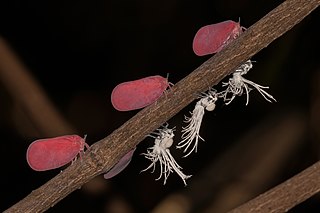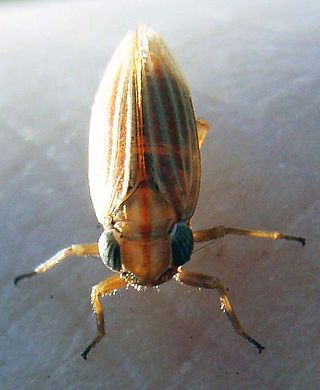
Ricaniidae is a family of planthopper insects, containing over 400 species worldwide. The highest diversity is in tropical Africa and Asia and in Australia, with a few species occurring in the Palearctic and Neotropical realms. It is one of the smaller families in the planthopper superfamily Fulgoroidea.

Dictyopharidae is a family of planthoppers, related to the Fulgoridae. The family comprises nearly 760 species in more than 150 genera which are grouped into two subfamilies, Dictyopharinae and Orgeriinae.

Flatidae are a family of fulgoroid planthoppers. They are cosmopolitan in distribution and are distinguished from others in the superfamily by a combination of characters. Like all other planthoppers, they suck phloem sap of plants. Some species are known to communicate with vibrations through the plant stems. Communication may be with mates, or with ants that tend the nymphs, protecting them and gathering honeydew secretions. Adults of some species have brightly coloured forewings which are tougher and known as tegmina unlike the membranous hindwings which are used for flight. Although a few can be identified by their coloration, most species requires dissection and examination under a microscope with access to literature on already described species.

Hysteropterum is a genus of planthoppers described by Amyot & Serville in 1843, belonging to the family Issidae, subfamily Issinae.

Issidae is a family of planthoppers described by Spinola in 1839, belonging to the order Hemiptera, suborder Auchenorrhyncha superfamily Fulgoroidea.

Caliscelidae is a family of planthoppers, sap-sucking insects that belong to the order Hemiptera, suborder Auchenorrhyncha and superfamily Fulgoroidea. They are somewhat anomalous and have often been included within the family Issidae. Studies made in 2013 of the phylogeny of the Issidae and other groups using molecular techniques support the treatment of the group as a separate family. Sexual dimorphism can be marked. Some members of the family are called piglet bugs due to the shape of their snout. A particularly aberrant genus described in 2011 from India, Formiscurra, has males that resemble ants.

Lophopidae is a family of fulgoroid plant-hoppers with most species found in tropical South America and Asia.
Falcidius is a genus of planthoppers in the family Issidae.
The Elicini are a tribe of planthoppers in the family Tropiduchidae. The type genus is Elica.

Achilidae is a family of planthoppers, sometimes called "achilids" in the order Hemiptera. There are at least 520 described species in Achilidae.

Thionia is a genus of planthoppers in the family Issidae. There are at least 60 described species in Thionia. However, several genera have been split off from Thionia reducing the number of species.

Elicinae is a subfamily of tropiduchid planthoppers in the family Tropiduchidae, with Elica the type genus.

Dictyopharinae is a subfamily of dictyopharid planthoppers in the family Dictyopharidae. There more than 100 genera and 500 described species in Dictyopharinae.

Agalmatium is a genus of planthoppers belonging to the family Issidae, subfamily Issinae.

Acanaloniidae is a family of planthoppers. It is sometimes treated as a subfamily of Issidae.

Dictyophara is the type genus of planthoppers belonging to the family Dictyopharidae and tribe Dictyopharini, containing five subgenera. The scientific genus name Dictyophara derives from the Greek and can be translated "who wears a net".

The Hemisphaeriinae are a subfamily of bugs in the family Issidae, based on the type genus Hemisphaerius. Species in 119 genera have been recorded in most continents, but the greatest diversity appears to be in South-East Asia.

Delphacini is an important tribe of planthoppers with a world-wide distribution.

Picumna is a genus of planthopper in the family Issidae. They can be found in the Southwestern United States and Central America. Picumna species are often confused with Thionia species, but can be differentiated as Picumna have four spines on their hind tibia, whereas Thionia have fewer.
















